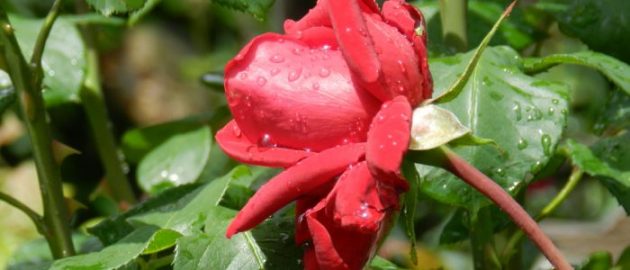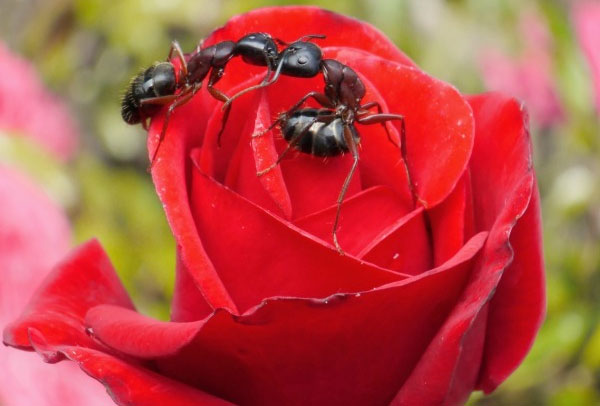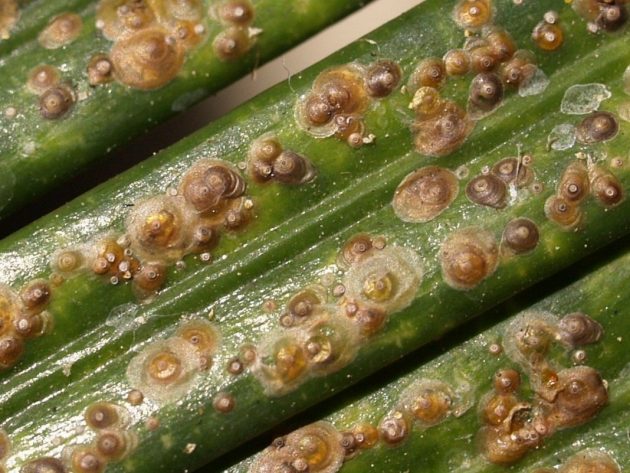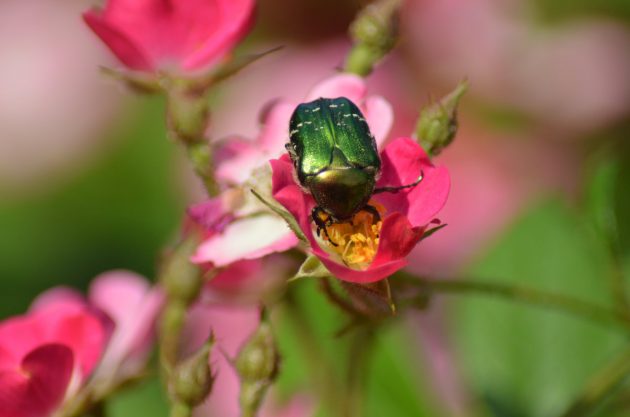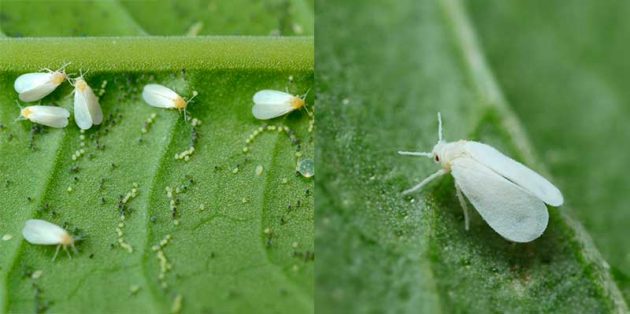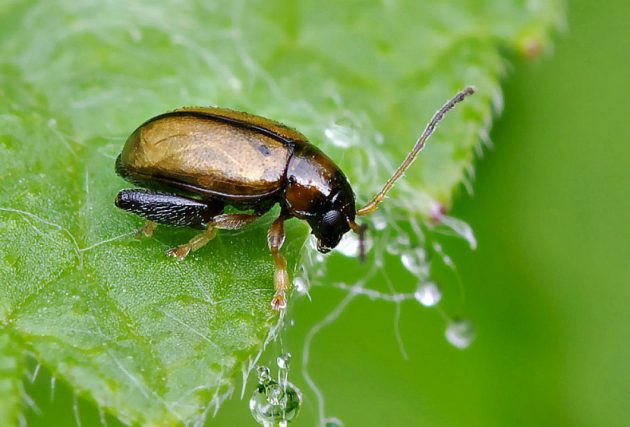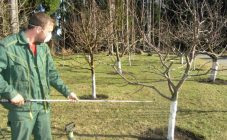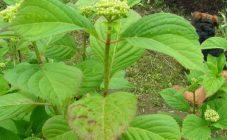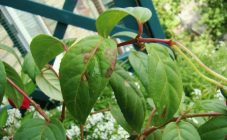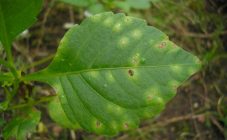Content:
If you do not start pest control on roses in a timely manner, the flowers will lose not only their own attractiveness, but as a result of severe damage they will most likely even die. Nevertheless, there are effective methods of prevention and control of parasites such as golden bronze, thrips, sawfly, spider mites, weevils, aphids, walnut and rose leafhoppers. From the publication, the reader will learn what are the pests of roses and how to eliminate them.
Before starting work, you need to think about your own safety. The substances used to treat plants are pesticides, therefore, they are toxic. Hands must be covered with rubber gloves, and it is best to use a respirator to protect the respiratory tract.
You should also carefully study the description of the drug and strictly observe the required dosage, in no case, not exceeding it. And after the completion of the work, open areas of the body, especially the hands and face, must be thoroughly soaped and washed off with water.
Insect harm to rose bushes
During the period of active growth, roses are very vulnerable and require additional protection measures, because their newly formed buds and first leaves are a source of food for pests and their larvae.
Many gardeners cannot immediately tell who is eating rose leaves. The danger is carried by both aphids and gnawing parasites: caterpillars, beetles, sawflies (especially their larvae). By reducing the size and damage to the surfaces, the plant slows down in growth, the volume and duration of flowering decreases. Gnawing pests are capable of the following:
- gnawing the pulp of the leaves around the veins in the form of holes, while the veins remain intact;
- gnawing at the edges of the sheet (usually curly);
- making passages through the body of the leaf (mining) and plant stems;
- eating buds and petals from the outer edge;
- eating stamens and pistils.
The most common sucking insects that harm rose bushes are mites, aphids, scale insects and cicadas (especially rose whiteflies). The above pests can appear both in protected and in open ground.
The most common pests of roses
The most annoying parasites for roses include:
Phytophthora
Phytophthora is a fungal infection that affects roses. The fungus can develop if the moisture in the root zone is high and can infect both healthy and weak plants.
How to deal if late blight is diagnosed on a rose:
- use only healthy planting material;
- monitor the purity of the substrate;
- prevent growing in waterlogged areas;
- take care of irrigation water: it must be warm and clean;
- steam the substrate before new plantings.
Rose aphid
Often whole colonies of aphids attack rose bushes. Usually these insects are located on the back of leaves or on stems, flower shoots and buds. The larvae of these insects are hardly distinguishable due to their extremely small size. But they quickly grow and develop into large wingless individuals, which soon become founding females, producing offspring of at least 100 larvae. Within 8-10 days, the newly hatched larvae grow and again give birth to another offspring.And so up to hundreds of thousands of parasites are born a year.
The presence of aphids on plants can be easily identified by the increased activity of ants feeding on the sweet juice secreted by these insects. They usually guard the settlements of these parasites and even transfer their females to new, not yet inhabited places to organize new settlements.
Ladybugs (seven-spotted) happily feed on aphids. One individual is able to eat up to 270 such larvae per day.
If green insects appear on the rose, what to do:
- treatment with contact pesticides during early spring and always before buds swell on the plants;
- insecticides: actellic, antio, karbofos, metathion, rogor.
- spraying with a solution consisting of water (10 l) and kerosene (2 g).
- treatment of plants with a specially prepared composition. It includes pounded onion or garlic (300 g) and tomato leaves (400 g). Both ingredients must be placed in a 3 liter jar, filled with water (to the brim) and left to infuse in a dark place for at least 6 hours. After this time, the infusion is opened, filtered and diluted with water so that 10 liters of liquid are obtained.
Leaf cutter bee
To build their cocoons, leaf-cutting bees use the leaves of plants, including roses. It is easy to understand that an invasion of these pests happened in the country, this species of bees leaves recesses in the shape of a semicircle on the leaves of rose bushes.
All traditional methods of dealing with leaf-cutting bees are focused on making plants lose their attractiveness to pests. How to treat a rose from these pests:
- Soapy water. To prepare a solution, 1 bar of any soap is diluted in 5 liters of water. Spray rose bushes with the prepared solution.
- Wood ash. The substance is sieved and generously sprinkled with leaves.
- Tobacco sprinkling. It is placed in a gauze bag and powdered with rose leaves.
- Pepper sprinkle. Place finely ground pepper (best hot) in a bag of gauze and sprinkle on the plants.
All of the above means have one indisputable advantage: they not only scare away bees, but also serve as prevention of the appearance of rose-colored aphids and other pests, regardless of who eats the leaves of the roses. However, it should be noted that their effectiveness is not very high. These compounds are easily washed off by rain, so bees may again become interested in plants if the treatment is not repeated in time.
Ants
As mentioned above, ants contribute to an increase in aphid colonies. Therefore, if these insects are found, it is worth getting rid of them first.
Several effective ways to control ants in rose gardens have been identified:
- The soil around the rose bush is generously sprinkled with spices or strong-smelling herbs that repel insects. You can, for example, use cinnamon, lavender or mint.
- Place some essential oil on the ground at the bottom of the rose bush. Tea tree or mint remedies work best. Their pungent smell will quickly scare off ants.
- Sprinkle generously the soil in the rose garden with semolina or millet groats. Experts assure that ants do not like them.
- Chemicals are recommended to be scattered around the plants. They are excellent at repelling pests. Such substances can be purchased at garden stores or fertilizer stores.
Shield
Damage to rose bushes in the garden by scabies occurs much less frequently than attacks by other insects (for example, spider mites or aphids). However, they do no less harm to plants.
Pregnant female pests masterfully hide on the back of the leaves. This leads to the fact that it is extremely difficult to determine the moment from which the defeat of the bush began. It is almost impossible to notice them immediately after their appearance.
But there are characteristic features by which the appearance of scale insects on rose bushes is easily detected:
- small spots of red or yellow appear on the upper side of the leaves;
- on the vegetative organs, a sugar pad appears, similar in appearance to the secretions of aphids;
- a sooty bloom appears on the leaves, they turn yellow and change (change shape);
- the growth of shoots stops.
It is much easier to get rid of scale insects if you start fighting in the early stages of plant damage. Therefore, it is extremely important to periodically carefully inspect the stems and the underside of the leaves of plants.
If there is a sticky bloom and tightly adhered insects on the foliage, then you should start the fight. Special preparations for the destruction of the scale insect have not yet been created. Therefore, the surest way is to mechanically clean off pests from plants with a cloth (less often a stick or brush) soaked in soapy water. For this, it is preferable to use a cloth, rather than rigid devices, it does not damage the surface of the leaves and stems of the rose. To completely get rid of the scabbard, you need to cleanse for several days.
If the accumulations of pests are small, then it is worthwhile to destroy the insects by spraying the plants with soapy water. It is additionally recommended to add a few drops of kerosene or engine oil to it (at the rate of 5-6 drops per 1 liter of solution) in order to deprive the pests of the ability to breathe.
Bronzovka
Who else is eating rosebuds in the garden? Bronze is a kind of greenish beautiful bugs. It is active from early May to late August. The beetles enjoy eating rose petals as food. They also like to eat away stamens and pistils.
Bronze females lay their eggs in the ground. By the end of summer, larvae hatch from them, which subsequently pupate in the ground, where beetles hatch. The latter hibernate in the soil and get out to the surface only with the arrival of heat (in May).
In the morning, the beetles sit motionless on flowers. At this time, they need to be collected and then burned. Also, rose bushes then need to be sprinkled with mustard. You can also cover the plants with a special net so that insects cannot get to them.
Whitefly
This insect looks like a white butterfly, reaching a length of 3 mm. It is a sucking parasite dangerous for plants. Its larvae extract juices from flowers, eat up the pulp and spread phytopathogenic diseases, which contributes to the destruction of the rose bush in the shortest possible time.
Adult pests easily fly from one rose bush to another, but the larvae move little, but stick tightly to the rose bush and are able to secrete a wax-forming substance that saves them from the effects of insecticides. In addition to roses, other plants also suffer from whiteflies:
- fuchsia;
- myrtle;
- ferns;
- eucalyptus;
- geranium;
- gloxinia;
- calla lilies;
- grenades;
- henbane.
To find these insects, it is enough to touch a rose bush in June. The swarm of pests will immediately take off. Even the appearance of white midges should be alarming. Plants should be checked immediately for contamination.
How to spray a rose in the summer from pests and diseases? It helps well in the fight against phytoverm whiteflies. It can be used without fear for the life and health of pets. It is also safe for humans. To completely eliminate the whitefly settlement, you will need to spray the plant about 3-4 times.
If fitoverm for some reason did not give a positive result, then it is recommended to use the substance Aktar or other insecticides in complex application. This agent causes paralysis of the digestive organs in insect larvae, and after 24 hours they starve to death.
This substance should be used both for sprinkling roses and for watering them, but plants can get used to the substance, which will reduce the effectiveness of the treatment. For this reason, it is better to alternate the insecticide with other substances, for example, confidor and tanrec. In difficult situations, highly toxic substances such as actellic are used. Alternatively, the following medications can be used:
- kinmix;
- carbofo;
- vertimek.
As folk methods in the fight against whitefly use:
- Ash solution. For its preparation 1 tbsp. wood ash must be dissolved in 5 liters of water and infused for 3-4 hours. After that, 50 g of any soap is added to it and the rose bushes are sprayed.
- Infusion of tobacco. To prepare it, you will need strong tobacco (you can gut 1 pack of cigarettes), which is poured into hot water, stirred and infused for 5 days. Then it is filtered and the resulting liquid is sprayed with rose bushes.
- Garlic infusion. You need to take 5 cloves of garlic, chop them, add water (250 ml) and leave to infuse in a closed vessel for 1-2 days. After that, the infusion is filtered through a thick (at least triple) layer of gauze and sprayed with rose bushes. It is easy to make a solution, the effect is positive.
Rose leafhopper
This type of pest is very common and can cause great harm to roses. Under the influence of these insects, the leaves of the plant lose their decorative effect, become "marble", and white small dots appear on their surface. With severe damage, the foliage turns yellow and falls off prematurely.
The best period for the destruction of pests is the time when larvae appear en masse (in autumn in September). During this period, plants should be treated with insecticides at least 2 times with an interval of 10-12 days. When processing, it is worth capturing the territory bordering the rose garden.
Leaf fleas
These are small jumping green insects on a rose - parasites that suck juice from the leaves. As a result, the bush is covered with small dots of white color, which gradually lead to the plant shedding greens prematurely. Climbing roses are especially susceptible to the invasion of such insects.
To combat these insects, insecticides such as confidor, bombardir, decis and others are used.
There are still no effective measures to prevent the appearance of flea beetles, as well as methods of treating plants from flower beetles, but it is advisable to use biological products to prevent the massive spread of insects.
Now, knowing almost everything about pests of roses, you can not be afraid to plant these luxurious flowers. In addition, if the prevention of parasites is carried out in time, ticks and fleas can completely bypass the rose garden.
